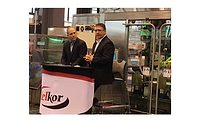
Recycled paperboard and PLA film are common elements in packaging that’s consistent with organic companies’ sustainable vision, and companies are receptive to more options-provided they support product sales. Source: Simon Candy Co.
Bagasse was a big buzz at the recent All Things Organic show in Chicago. Made from the waste of sugarcane stalks after juice is extracted, bagasse joins palm fiber and other Southeast Asian pulp on a lengthening list of natural alternatives to conventional paper containers. “It’s used mostly for egg cartons, but we’re looking for a more glamorous look to expand the appeal,” reports Nicole Smith, environmental director for New York-based Design & Source Production Inc. (DSP)
DSP featured bagasse packaging at its organics show booth, and while the display drew considerable interest, practical considerations trump eco-friendly possibilities. “The only problem we have with packaging like that is, we need a barrier,” notes Nicole Dawes, president and founder of Late July Organic Snacks, Hyannis, MA.
Functionality comes first, agrees Libby Moyer, marketing manager for the College Farm Organic division of Elizabethtown, PA-based Simon Candy Co., but appearance also is critical. “There are films available from compostable or renewable material, but unfortunately it doesn’t print well,” she says. “If you can’t sell it, you can’t use it.” PLA film from cornstarch and recycled paper are used with College Farm’s organic-ingredient candies. But PLA is difficult to machine and has a low melt temperature: Just-made lollipops melted the bags initially.
PLA is the first commercial hit among the so-called biopolymers, compostable and biodegradable plastic that performs the same as some petroleum-based films. Among them is NatureFlex, a film similar to cellophane but based on wood pulp. Heat-seal resins are laminated to the film for static-free machining and good gas- and moisture-barrier properties. Atlanta-based Innovia Films Inc. introduced the film in 2003.
“We sold more NatureFlex in the first five months this year than all of last year,” boasts Malcolm Cohn, Innovia’s marketing manager-Americas. Interest is driven by “environmental activists,” and Cohn lumps Wal-Mart in that group. “I don’t go along with the accusation Wal-Mart is engaging in ‘greenwashing’ [ecological whitewashing of the company’s image],” he says. Wal-Mart’s sustainable packaging initiative should help reduce the 25% premium over conventional films that Innovia currently charges, Cohen adds.
Troy, MI-based Cadillac Products Packaging Co. recently began qualifying its biodegradable polyethylene film for use with food, according to Christopher Mitchell. “PE film by itself can take hundreds of years to biodegrade,” Mitchell says. “With a proprietary-resin additive, we can accelerate that to five years.” Water-based inks yield less than optimum print quality, though, and Cadillac is working with Innovia to laminate its film to the biodegradable PE to deliver film that is both attractive and a good barrier.
For more information:
Christopher Mitchell, Cadillac Products Packaging Co., 248-930-8884, cgmitchell@cadprod.com
Nicole Smith, Design & Source Production Inc., 212-265-8632, nicole@dsnyc.com
Malcolm Cohn, Innovia Films Inc., 404-784-4814, malcolm.cohn@innoviafilms.com
Larry Clark, RNC Industries Inc., 770-368-8453, larry@rncind.com

A Lichtenstein it isn’t, but Jamey Jackson’s design was good enough to win a Pepsi can design contest that drew more than 90,000 Web site entries. Source: Pepsi-Cola North America.
Meet the new design team (cue mirror)
Idle Americans not only can sing, they can be put to all sorts of useful/productive tasks. From TV jingles to public parks, consumers are being asked to contribute creative skills to a wide variety of jobs formerly assigned to professionals.One recent outsourced creative assignment is package design, specifically aluminum cans containing Pepsi. The Purchase, NY-based beverage firm attracted more than 90,000 entries to www.designourpepsican.com this spring, according to Pepsi spokesperson Nicole Bradley. Five finalists were selected, with Web voters determining the winning design, which was submitted by Jamey Jackson of West Nyack, NY. The design nets Jackson $10,000 and display space on 500 million cans that will reach stores in November. Bradley doesn’t know how many votes were cast in balloting.
In its first 109 years, Pepsi changed package graphics 10 times. This year, 35 different designs will be featured. “Consumers, especially young millennials, want to be more involved and make a personal connection,” explains Bradley, “and we’re a youthful brand.” Sports figures and entertainers also have designed Pepsi cans this year.
Secondary packaging changes with the can designs, but Bradley insists no complaints have come bottlers who must cope with the frequent changeovers. “It’s pretty seamless for them,” she says. “When they run out of one design, we just supply them with another.”

Can't beat ‘em? Buy ‘em
There were a number of reasons for Cambridge, MA-based Grace Darex Packaging Technologies to acquire Spain’s Grupo Sistiaga SL, notably the geographic expansion the deal delivered. But the real clincher was the specialty coating Sistiaga had developed for highly contoured aluminum bottles.Since its introduction a few years ago as a novelty package for Heineken and Iron City beer, seamless aluminum bottles have emerged as one of the fastest growing container types in the world. Coca-Cola’s cola-coffee concoction Blak? raised the metal bottle’s profile in France last year and helped expand applications beyond beer and into the soft drink segment. This spring, Pepsi-Cola rolled out a series of highly decorative bottles under the Mountain Dew brand. An estimated 180 million contoured cans were produced for the US market in 2005-2006, and Grace Darex officials expect 50% annual growth for the foreseeable future

Aluminum bottles like Mountain Dew’s Green Label Art series are proving popular with marketers and the public, but they pose special coating problems for container manufacturers. Source: Pepsi-Cola Co.
Grace Darex offers a range of food & beverage can and closure sealants and coatings. The Sistiaga acquisition “expands our coatings technology capabilities and allows us to respond to the fast-growing aluminum bottle segment,” concludes Sorrentino.
For more information:
Robert Sorrentino, Grace Darex Packaging Technologies, 617-876-1400


